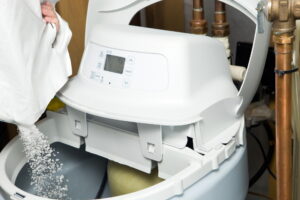
You might not have paid much attention in your high school chemistry class, but we’d like you to pay attention now. If you’re looking into options for water softening in your home, and you’re sick and tired of dealing with hard water, then this is the blog post for you. Wouldn’t it be nice for someone to tell you exactly how water softening actually works? Not just some layman’s terms description, but a really accurate scientific description?
Well, it’s time to dive into the science of water softening. We’re going to talk about how water softeners work, the chemical process that takes place, and why it’s such an effective method at cleaning your water and leaving you with a grateful plumbing system.
If you’re interested in this type of technology, be sure to call us to install a water softener in your home.
How It Works
Water softeners function via two tanks. One of them is the “brine tank” while the other one is the “resin tank” or “water softener.” We need to approach these tanks one at a time to understand the fundamental process of water softening. We promise, once you understand how this system works, you’ll realize how effective the technology is at stopping the problem of hard water in its tracks and keeping you happy.
The Water Softening Tank
Your water is filtered through a water softening tank filled with plastic beads that are called “resin.” The resin is ionized to attract the minerals and hard molecules in your water so that they bond together. Think of them like magnets that are prone to picking up all of the things in your water that cause it to be uncomfortably hard.
As your water gets filtered to the bottom of the resin tank, these beads pick up most of the minerals that would normally make your water hard. This is great, because then it can just be filtered out and pumped to the rest of your home as soft water. It’s really as simple as that!
The Brine Tank
When the beads become bound to too many minerals, they need to be recharged so that they can effectively remove more minerals from your incoming water. That’s where the brine tank comes in. It’s basically just a tank full of saltwater!
This saltwater is pumped into the resin tank, or water softening tank, which then loosens the minerals bonded to the plastic beads. As all of the saltwater absorbs the minerals that have been collected by the resin tank, it then gets flushed out of the system so your regular hard water can be pumped in it again and the whole cycle is refreshed. Eventually, the brine tank will need recharging, but this usually takes a long time and will keep you happy for years.
By using chemistry and a little bit of water pumping, the minerals in your water that cause you so much trouble can be removed with incredible efficiency. If that’s not a great technological solution to your problem, then we don’t know what is!
Call the team at Ken Neyer Plumbing, Inc. to get yourself a fully functioning water softener.
